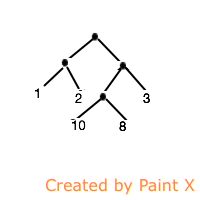泛函编程(8)-数据结构-Tree
上节介绍了泛函数据结构List及相关的泛函编程函数设计使用,还附带了少许多态类型(Polymorphic Type)及变形(Type Variance)的介绍。有关Polymorphism的详细介绍会放在typeclass讨论中。为了更多了解泛函数据结构(Functional Data Structure),想在这个章节把另一个我们熟悉的数据结构-Tree做些简单介绍。
Tree的状态不是枝(Branch)就是叶(Leaf),这个很容易理解。那么就按照上节设计List那样设计Tree类型:
1 trait Tree[+A] 2 case class Leaf[A](value: A) extends Tree[A] 3 case class Branch[A](left: Tree[A], right: Tree[A]) extends Tree[A]
类参数+A代表协变(covariant),这个在上节List中已经介绍过了。先创建一个Tree实例(Tree Instance):
1 val tree = Branch(Branch(Leaf(1),Leaf(2)),Branch(Branch(Leaf(10),Leaf(8)),Leaf(3))) 2 //> tree : ch3.tree.Branch[Int] = Branch(Branch(Leaf(1),Leaf(2)),Branch(Branch( 3 //| Leaf(10),Leaf(8)),Leaf(3)))
创建了一个Tree Instance tree,如下图:

数数有几个节点:
1 def size: Int = this match { 2 case Leaf(_) => 1
3 case Branch(l,r) => 1 + l.size + r.size 4 }
1 tree size //> res0: Int = 9
这是所有branch + leaf 总数。
分开计算branch 和 leaf 数量:
1 def countLeafs: Int = this match { 2 case Leaf(_) => 1
3 case Branch(l,r) => 0 + l.size + r.size 4 } 5 def countBranches: Int = this match { 6 case Leaf(_) => 0
7 case Branch(l,r) => 1 + l.size + r.size 8 } 9
1 tree.countLeafs //> res1: Int = 8
2 tree.countBranches //> res2: Int = 9
探探最深有多深:
1 def depth: Int = this match { 2 case Leaf(_) => 0
3 case Branch(l,r) => 1 + (l.depth max r.depth) 4 }
1 tree depth //> res1: Int = 3
找出最大值的Leaf:
1 def maxValue: Int = this match { 2 case Leaf(a: Int) => a 3 case Branch(l,r) => l.maxValue max r.maxValue 4 }
1 tree maxValue //> res2: Int = 10
可以从以上这些函数得出一下共性。把共性抽象出来用fold来实现:
1 def fold[B](f: A => B)(g: (B,B) => B): B = this match { 2 case Leaf(n) => f(n) 3 case Branch(l,r) => g(l.fold(f)(g), r.fold(f)(g)) 4 }
函数fold分别收到两个方法f,g:f用来处理Leaf,g用来处理Branch。看看用fold来实现上面的函数:
1 def sizeByfold = fold(a => 1)(1 + _ + _) 2 def maxValueByfold(l: Tree[Int]) = l.fold(a => a)((x,y) => 0 + (x max y)) 3 def depthByfold = fold(a => 0)((x,y) => 1 + (x max y))
1 tree sizeByfold //> res3: Int = 9
2
3 tree depthByfold //> res4: Int = 3
4
5 tree.maxValueByfold(tree) //> res5: Int = 10
可能这个 tree.maxValueByfold(tree) 有点怪,但如果把函数实现放到 object Tree里然后import Tree._就可以了。
下面把map和flatMap实现了:
1 def map[B](f: A => B): Tree[B] = this match { 2 case Leaf(a) => Leaf(f(a)) 3 case Branch(l,r) => Branch(l.map(f),r.map(f)) 4 } 5 def flatMap[B](f: A => Tree[B]): Tree[B] = this match { 6 case Leaf(a) => f(a) 7 case Branch(l,r) => Branch(l.flatMap(f), r.flatMap(f)) 8 }